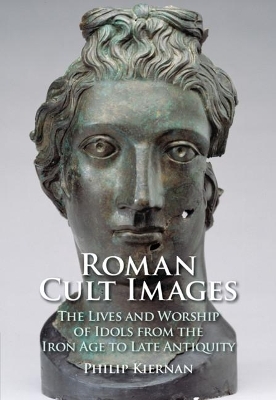
Roman Cult Images
The Lives and Worship of Idols from the Iron Age to Late Antiquity
Seiten
2020
Cambridge University Press (Verlag)
978-1-108-48734-4 (ISBN)
Cambridge University Press (Verlag)
978-1-108-48734-4 (ISBN)
This book explores how Roman cult images were created, used, and eventually destroyed, from the Iron Age to Late Antiquity. Useful to both undergraduates and faculty readers studying ancient art, Roman archaeology, ancient religion, the European Iron Age, and Late Antiquity.
In this book, Philip Kiernan explores how cult images functioned in Roman temples from the Iron Age to Late Antiquity in the Roman west. He demonstrates how and why a temple's idols, were more important to ritual than other images such as votive offerings and decorative sculpture. These idols were seen by many to be divine and possessed of agency. They were, thus, the primary focus of worship. Aided by cross-cultural comparative material, Kiernan's study brings a biographical approach to explore the 'lives' of idols and cult images - how they were created, housed in temples, used and worshipped, and eventually destroyed or buried. He also shows how the status of cult images could change, how new idols and other cult images were being continuously created, and how, in each phase of their lives, we find evidence for the significant power of idols.
In this book, Philip Kiernan explores how cult images functioned in Roman temples from the Iron Age to Late Antiquity in the Roman west. He demonstrates how and why a temple's idols, were more important to ritual than other images such as votive offerings and decorative sculpture. These idols were seen by many to be divine and possessed of agency. They were, thus, the primary focus of worship. Aided by cross-cultural comparative material, Kiernan's study brings a biographical approach to explore the 'lives' of idols and cult images - how they were created, housed in temples, used and worshipped, and eventually destroyed or buried. He also shows how the status of cult images could change, how new idols and other cult images were being continuously created, and how, in each phase of their lives, we find evidence for the significant power of idols.
Philip Kiernan is Associate Professor of Art History at Kennesaw State University, Georgia. He is the author of Miniature Votive Offerings (2009) and has also published numerous articles on Roman art, artefacts, numismatics, and religion. His archaeological excavations have included a Hellenistic-Roman market building at Alexandria Troas, a Bronze-Iron Age tumulus at Haßloch, and most recently a Romano-Celtic temple at Wareswald.
1. The birth of cult images: early Rome and the Iron Age; 2. The birth of cult images: continuity and innovation in the Imperial Period; 3. Idols at home; 4. Idols in action; 5. The end of idols.
| Erscheinungsdatum | 15.06.2020 |
|---|---|
| Zusatzinfo | Worked examples or Exercises; 94 Halftones, black and white |
| Verlagsort | Cambridge |
| Sprache | englisch |
| Maße | 185 x 260 mm |
| Gewicht | 940 g |
| Themenwelt | Kunst / Musik / Theater ► Kunstgeschichte / Kunststile |
| Geisteswissenschaften ► Archäologie | |
| Geschichte ► Allgemeine Geschichte ► Vor- und Frühgeschichte | |
| Geschichte ► Allgemeine Geschichte ► Altertum / Antike | |
| ISBN-10 | 1-108-48734-3 / 1108487343 |
| ISBN-13 | 978-1-108-48734-4 / 9781108487344 |
| Zustand | Neuware |
| Informationen gemäß Produktsicherheitsverordnung (GPSR) | |
| Haben Sie eine Frage zum Produkt? |
Mehr entdecken
aus dem Bereich
aus dem Bereich
Was Pompeji über uns erzählt
Buch | Hardcover (2023)
Propyläen (Verlag)
32,00 €
auf den Spuren der frühen Zivilisationen
Buch | Hardcover (2023)
C.H.Beck (Verlag)
20,00 €


